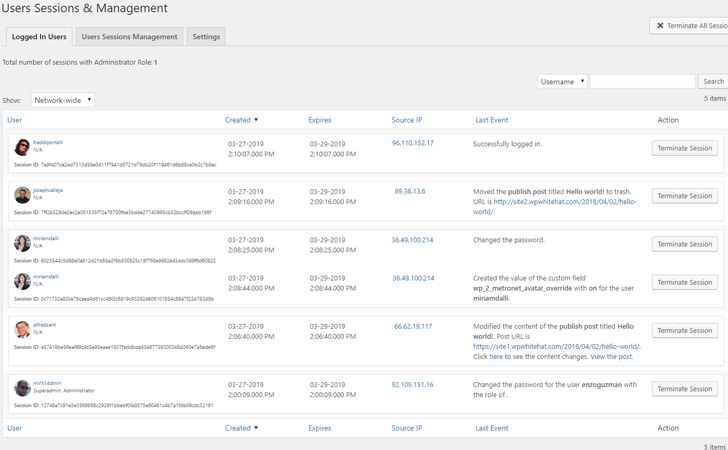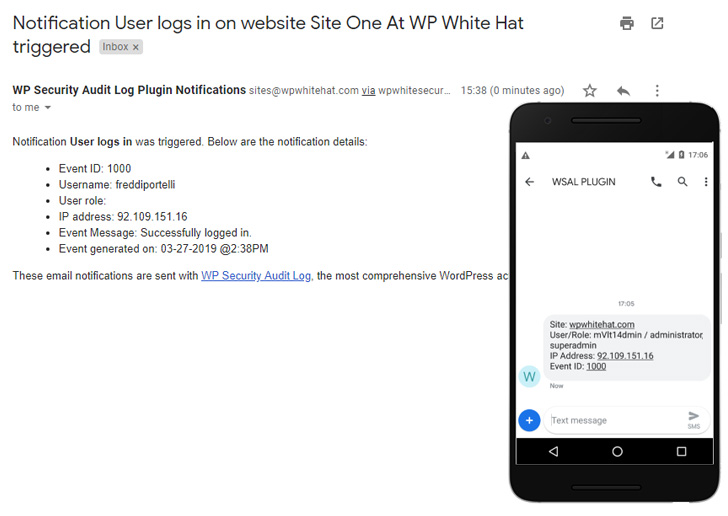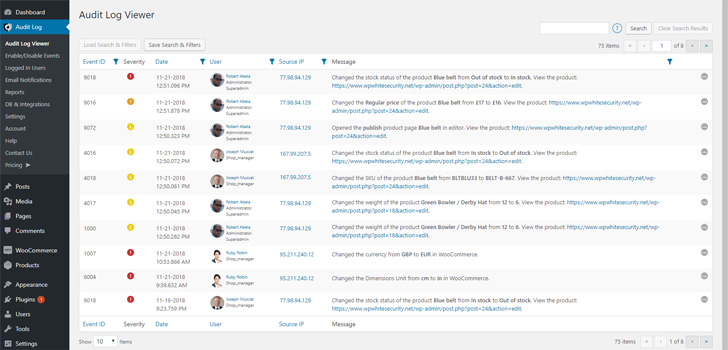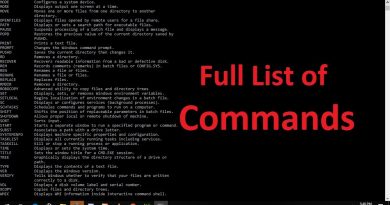How Activity Logs Help WordPress Admins Better Manage Website Security

Managing a WordPress website can sap a lot of your time and energy, which otherwise you’d spend on managing your business.
If you’re looking to cut down on the hours, you spend troubleshooting WordPress technical and security problems, better managing and monitoring your website and users, or your customers, you need a WordPress activity log plugin.
This post explains how to use the WP Security Audit Log plugin to keep a WordPress security audit log (aka activity log). It also highlights five ways an activity log helps you better manage your website and users and improve its security.
WordPress Security Audit Logs – Introduction and Benefits
An activity log is a record of everything that happens on your WordPress website. This includes a record of plugins, themes, and WordPress core changes, users activity (such as content changes), site settings changes, break-in attempts, WooCommerce store, and product changes, and everything else that happens on your website.
WordPress does not have any built-in logging mechanisms. So the best way to keep a security audit log on your website is to install the WP Security Audit Log plugin. It is the most comprehensive activity log/audit trail plugin with the broadest coverage.
The benefits of keeping an activity log on WordPress
WordPress site administrators enjoy a lot of benefits when they keep an activity log. To mention a few, with activity logs you can:
- Ease troubleshooting, as you can pin down the source of the problem quickly,
- Know exactly what is happening on your site and take full control of it,
- Improve user accountability and productivity,
- Meet mandatory regulatory compliance requirements,
- Learn how attackers are trying to break into your website, allowing to improve its security,
- Set up an intrusion detection system (IDS) to be instantly alerted via SMS or emails of critical site changes or problems,
- and much more!
How activity logs help you better manage your WordPress site and users
1. Know who is logged into your site and what they are doing
WordPress is a multi-user web application. So it is imperative to know from where users are logging in, when, and what they are doing. This is a must, especially when running a remote team and also for the security of your website. Since WP Security Audit Log keeps a log of everything, this information is close to hand:

For those who manage large, multi-author sites, WP Security Audit Log can also show who is logged in to the website and their latest change, in real-time.

With so much information at your fingertip, you’ll be able to manage your team and website better. You’ll also be able to easily spot suspicious behavior, login attempts, and more.
2. Note website core, plugins & themes installations and updates
A fundamental security best practice is to keep your WordPress core, plugins, themes, and all the software you use up-to-date. However, sometimes, updates can also lead to compatibility and technical issues. Or even worse, it is not uncommon for attackers who manage to gain unauthorized access to install malicious plugins, or infect already installed ones.
By keeping track of all your website updates, the activity log is the tool that will point you in the right direction. In it, you will find the source of the problem, which helps you resolve the problem quickly. Be it a hacker or well-intentioned user, with audit trails you can track down unauthorized and problematic changes without doing any guesswork.
3. Keep track of WordPress settings changes
Some WordPress settings changes can have a significant impact on the behavior of a website. Some others go unnoticed. What if someone changes the default role of new users to administrators by mistake, or intentionally? You won’t be able to notice much change until a new user finds out they have admin access.
WordPress audit logs enable you to be aware of everything that’s happening on your site, including WordPress settings changes. This means you’ll be able to identify the issue, who did it and when. And till also allows you to reverse unwanted changes with ease.
4. Build a WordPress Intrusion Detection System (IDS)
An activity log is an excellent asset in a post hack scenario. It helps you recover after an attack. Though more importantly, it enables you to prevent WordPress hack attacks from happening. Audit logs are the core of a WordPress Intrusion Detection System (IDS).
When you set up an IDS, it will alert you to suspicious activity. Therefore it helps you avoid successful hack attacks, so you do not have to deal with the aftermath and the expenses.

Putting theory into practice: you can set up alerts for when there are login attempts outside regular working hours, or from unfamiliar IP addresses. You can also set up notifications for when there are critical WordPress settings changes that alter the website’s functionality.
Bonus: Activity logs for WooCommerce / eCommerce stores
Activity logs are also very popular on eCommerce websites powered with WooCommerce. Audit trails make managing your online store smoother and increase users’ accountability.
The WP Security Audit Log is also an activity log for WooCommerce. It keeps plugin keeps a log of WooCommerce store, products, orders, and other changes.

It reports all the necessary details so you can stay on top of the game. The plugin keeps a log of what actually changed and which store manager changed an order, a store setting, a discount coupon, or a product. It reports if it was a quantity change, price change, or stock quantities adjustments.
Improving WordPress website management & security with activity logs
WordPress management is a necessity; however, it can take away from other business responsibilities. Activity logs help you gain a full overview of what is happening on your site, better manage your team and improve its security.
In return, you’ll have time to take care of your business matters faster and more effectively. This includes the ability to:
- Know who is logged into your site and what they are doing
- Note website core, plugins & themes installations and updates
- Keep track of WordPress settings changes
- Build a WordPress Intrusion Detection System (IDS)
- Keep track of your WooCommerce store, orders, and shop managers.



